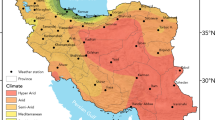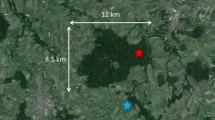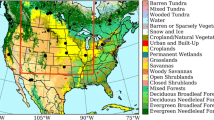Abstract
The evaluation of thermal bioclimate can be conducted employing either observational or modeling techniques. The advantage of the numerical modeling approach lies in that it can be applied in areas where there is lack of observational data, providing a detailed insight on the prevailing thermal bioclimatic conditions. However, this approach should be exploited carefully since model simulations can be frequently biased. The aim of this paper is to examine the suitability of a mesoscale atmospheric model in terms of evaluating thermal bioclimate. For this, the numerical weather prediction Weather Research and Forecasting (WRF) model and the radiation RayMan model are employed for simulating thermal bioclimatic conditions in Greece during a 1-year time period. The physiologically equivalent temperature (PET) is selected as an index for evaluating thermal bioclimate, while synoptic weather station data are exploited for verifying model performance. The results of the present study shed light on the strengths and weaknesses of the numerical modeling approach. Overall, it is shown that model simulations can provide a useful alternative tool for studying thermal bioclimate. Specifically for Greece, the WRF/RayMan modeling system was found to perform adequately well in reproducing the spatial and temporal variations of PET.






Similar content being viewed by others
References
Charalampopoulos I, Tsiros I, Chronopoulou-Sereli A, Matzarakis A (2013) Analysis of thermal bioclimate in various urban configurations in Athens, Greece. Urban Ecosyst 16:217–233
Chen F, Dudhia J (2001) Coupling an advanced land-surface/hydrology model with the Penn State/NCAR MM5 modeling system. Part I: Model description and implementation. Mon Weather Rev 129:569–585
CIA (2013) The World Factbook 2013–14, Central Intelligence Agency, Washington DC (Available online at: https://www.cia.gov/library/publications/the-world-factbook/index.html; last accessed on April 4 2014)
De Freitas CR, Matzarakis A, Scott D (2007) Climate, tourism and recreation: a decade of the ISB’s commission on climate, tourism and recreation. In Proceedings 3rd International Workshop on Climate, Tourism and Recreation, 19–22 September 2007, Alexandroupolis, Greece
Dudhia J (1989) Numerical study of convection observed during the winter monsoon experiment using a mesoscale two-dimensional model. J Atmos Sci 46:3077–3107
Endler C, Matzarakis A (2011) Analysis of high-resolution simulations for the Black Forest region from a point of view of tourism climatology—a comparison between two regional climate models (REMO and CLM). Theor Appl Climatol 103:427–440
Fanger PO (1972) Thermal comfort. McGraw-Hill, New York
Fröhlich D, Matzarakis A (2013) Modeling of changes in thermal bioclimate: examples based on urban spaces in Freiburg, Germany. Theor Appl Climatol 111:547–558
Gagge AP, Fobelets AP, Berglun LG (1986) A standard predictive index of human response to the thermal environment. ASHRAE Trans 92:709–731
Giannaros TM, Melas D, Daglis IA, Keramitsoglou I (2013a) Numerical study of the urban heat island over Athens (Greece) with the WRF model. Atmos Environ 73:103–111
Giannaros TM, Melas D, Ziomas, I (2013b) Performance evaluation of a mesoscale modeling system for wind resource assessment. 13th International Conference on Environmental Science and Technology, 5–7 September 2013, Athens, Greece
Gulyás A, Unger J, Matzarakis A (2006) Assessment of the microclimatic and human comfort conditions in a complex urban environment: modeling and measurements. Build Environ 41:1713–1722
Hong SY, Lim JOJ (2006) The WRF single-moment 6-class microphysics scheme (WSM6). J Korean Meteor Soc 42:129–151
Höppe PR (1984) Die Energiebilanz des Menschen. Dissertation, Wissenschaftliche Mitteilungen des Meteorologischen Instituts der Universität München 49
Höppe PR (1993) Heat balance modeling. Experientia 49:741–746
Höppe PR (1999) The physiological equivalent temperature—a universal index for the biometeorological assessment of the thermal environment. Int J Biometeorol 43:71–75
ISO (1982) ISO 7243: hot environments—estimation of the heat stress working man based on WBGT index (Wet Bulb Globe Temperature). International Organization of Standardization, Geneve
Janjic ZI (1994) The step-mountain eta coordinate model: further developments of the convection, viscous sublayer and turbulence closure schemes. Mon Weather Rev 122:927–945
Janjic ZI (1996) The surface layer in the NCEP Eta model. 11th Conference on Numerical Weather Prediction, 19–23 August 1996, Norfolk, VA, USA
Janjic ZI (2002) Nonsingular implementation of the Mellor-Yamada level 2.5 scheme in the NCEP meso model. NCEP Office Note 437, 61 pp
Kain JS (2004) The Kain-Fritsch convective parameterization: An update. J Appl Meteorol 43:170–181
Katsafados P, Papadopoulos A, Mavromatidis E, Gikas N (2011) Quantitative verification statistics of WRF predictions over the Mediterranean region. 12th Annual WRF Users’ Event, 20–24 June 2011, Boulder CO
Lara-Fanego V, Ruiz-Arias JA, Pozo-Vazquez D, Santos-Alamillos FJ, Tovar-Pescador J (2012) Evaluation of the WRF model sola irradiance forecasts in Andalusia (southern Spain). Sol Energ 86:2200–2217
Matzarakis A (2006) Weather- and climate-related information for tourism. Tourism Hospit Plann Dev 3(2):99–115
Matzarakis A, Mayer H (1996) Another kind of environmental stress: thermal stress. WHO Newsletter 18:7–10
Matzarakis A, Mayer H (1997) Heat stress in Greece. Int J Biometeorol 41:34–39
Matzarakis A, Nastos P (2011) Human-biometeorological assessment of heat waves in Athens. Theor Appl Climatol 105:99–106
Matzarakis A, Rutz F, Mayer H (2007) Modeling radiation fluxes in simple and complex environments—application of the RayMan model. Int J Biometeorol 51:323–334
Matzarakis A, Rutz F, Mayer H (2010) Modeling radiation fluxes in simple and complex environments: basics of the RayMan model. Int J Biometeorol 54:131–139
Mayer H (1993) Urban bioclimatology. Experientia 49:957–963
Mayer H, Höppe P (1987) Thermal comfort of man in different urban environments. Theor Appl Climatol 38:43–49
Miao JF, Chen D, Borne K (2007) Evaluation and comparison of Noah and Pleim-Xiu land surface models in MM5 using GOTE2001 data: spatial and temporal variations in near-surface air temperature. J Appl Meteorol Climatol 46:1587–1605
Mlawer EJ, Taubman SJ, Brown PD, Iacono MJ, Clough SA (1997) Radiative transfer for inhomogeneous atmosphere: RRTM, a validated correlated-k model for the long-wave. J Geophys Res 102(D14):16663–16682
Nastos PT, Matzarakis A (2006) Weather impacts on respiratory infections in Athens, Greece. Int J Biometeorol 50:358–369
Papangelis G, Tombrou M, Dandou A, Kontos T (2012) An urban “green planning” approach utilizing the Weather Research and Forecasting (WRF) modeling system. A case study of Athens, Greece. Landscape Urban Plan 105:174–183
Parsons K (1993) Human thermal environments. Taylor & Francis, London
Shiue I, Matzarakis A (2011) Estimation of the tourism climate in the Hunter Region, Australia, in the early twenty-first century. Int J Biometeorol 55:565–574
Skamarock WC, Klemp JB, Dudhia J, Gill DO, Barker DM, Duda MG, Huang XY, Wang W, Powers JG (2008) A description of the advanced research WRF version 3. NCAR Technical Note, NCAR/TN-475 + STR, June 2008, Boulder CO, 125 pp
Steadman RG (1971) Indices of wind chill of clothed persons. J Appl Meteorol 10:674–683
Thom EC (1959) The discomfort index. Weatherwise 12:57–60
Author information
Authors and Affiliations
Corresponding author
Rights and permissions
About this article
Cite this article
Giannaros, T.M., Melas, D. & Matzarakis, A. Evaluation of thermal bioclimate based on observational data and numerical simulations: an application to Greece. Int J Biometeorol 59, 151–164 (2015). https://doi.org/10.1007/s00484-014-0832-6
Received:
Revised:
Accepted:
Published:
Issue Date:
DOI: https://doi.org/10.1007/s00484-014-0832-6




